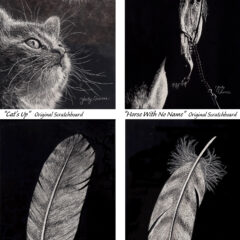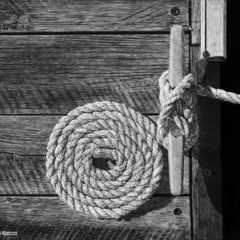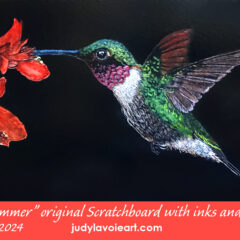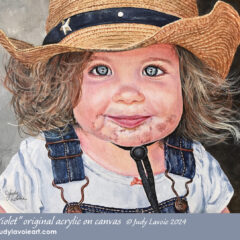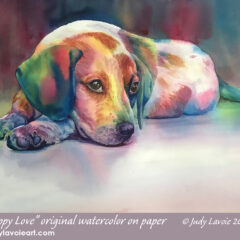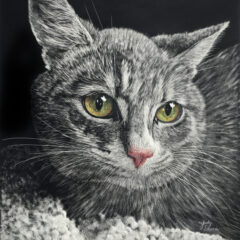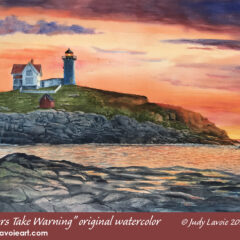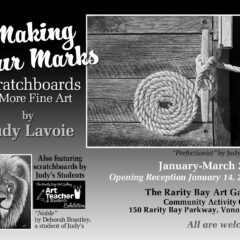“Barnyard Bouquet” is one of my paintings which several people have told me they would like to purchase. Too late now… the original was bought by my sweet friend Ginny and hangs in her flower-filled sunroom. By popular demand, I’ve just produced a limited edition of signed and numbered giclee prints, so it can hang on your wall too!
The new prints are on canvas, just as I painted the original, and they are museum quality. The reproduction quality is so good that the prints are hard to tell from original. They are a standard size, 11″ x 14″, and priced at $100, unframed. The sides of the canvas are black and the canvas is attached to the back side of the wood stretchers, so the artwork could actually be hung with no frame. But, for those who want a more finished look, ready-made frames are sold to fit this size at craft and hobby stores, or a custom frame with a white linen liner would look fabulous!
These days there are many ways to make reproductions on canvas and paper. I always have my giclees made by fine art reproduction studios. This way I am assured that the surface, the pigments, and the protective surface coatings adhere to high standards.
What is a “GICLEE”? The “giclée” (pronounced gee-clay) print represents the finest technology in digital fine art limited editions. The process began as an “iris” print, which I first used as a commercial artist back in the 80s for pre-press color proofing. But these early versions used inks which faded fast and they were not printed on quality paper, because they were meant to have a short shelf life… discarded soon after being viewed. As the Iris printing process became familiar to photographers and artists, the demand grew for long-lasting permanent pigments and high quality surfaces. Rock musician Graham Nash, an accomplished black and white photographer, spearheaded the drive to use the Iris technology for museum-quality reproductions in the late 1980s. His fame likely helped move the process forward, and Iris prints morphed into fine art Giclee prints. Nash’s original IRIS 3047 graphics printer is now in the Smithsonian’s National Museum of American History! Nash Editions still offers fine quality digital giclee printmaking services to photographers and artists from all around the world.
I was attracted to giclée reproductions many years ago, when I first decided to make prints from my paintings, because this technology captures the detail and subtle color nuances of my original paintings better than other printing methods. A giclée exhibits the look and feel of the original painting, right down to the surface it is printed on – archival paper or artist’s canvas. The giclée ink is waterbased – like the watercolor and acrylic pigments I paint with. The giclée process is truly a high tech marriage of fine art, graphic art, and state of the art.
With many years of graphic experience (I could be considered a dinosaur in the field!) I make fine color adjustments to my own digital photographs until they match my original artwork. When the image is correct, the digital files are transmitted to a giclee printer, which is a very high-end ink-jet type of fine art printer. Giclée is a French word which means “squirt” or “spurt” and alludes to the production process, where the printer squirts approximately 4 million microscopic droplets of ink per second from each of its precision nozzles, creating a continuous tones of color. The name was likely chosen to make it sound exotic (makes me think of “Häagen-Dazs,” invented in the Bronx to make people relate the ice cream to high quality Danish dairy products!). In the giclee process, each particle of color is defined by these microscopic droplets of ink (the droplet is four times smaller than a human hair). This allows for the capture of the finest detail from the original painting, with the highest resolution possible. Even under a magnifying glass, the giclée print looks like an original.
Each of my giclées is signed and numbered and provided with a certificate of authenticity. A giclée should be handled as fine art; frame a giclée on paper with matting and glazing and hang away from direct sunlight or accidental exposure to moisture. A giclée on canvas can be framed without matting and glazing, like an original painted canvas. My canvas giclées have a top coating with UV protection, and the surface can, and should, be dusted as needed with a soft dry cloth. Giclée printing has become a fine art in itself, and art museums now recognize and hang artwork reproduced as fine art giclées.

